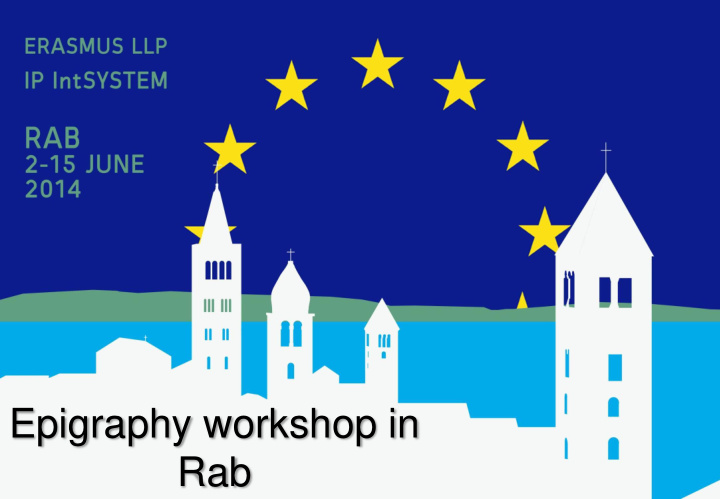



Epigraphy workshop in Rab
Epigraphy workshop in Rab Part I: A second week in Rab Part II: Epigraphy in Rab: preliminary conclusions Part III: Prospects
Part I: a second week in Rab More inscriptions -Completing the collection with new records: 54 inscriptions seen, almost 40 records registered - How to get thorough: more detailed and precise descriptions and better modern localization
Part I: a second week in Rab Field survey -5 new Roman inscriptions !
TRANSCRIPTION Commentary (if necessary) --] N IA [---------------------]B . x To be compared with CIL 3, 3118, supposedly found in St Stephen COS II (hedera) IMP II tower: D (hedera) D Imp(eratori) Caesari / divi Antonini fil(io) / divi Hadriani nep(oti) / [di]vi Traiani Parthi/[ci p]ronepoti / [div]i Nervae ab/[n]epoti / M(arco) Aurelio Anto/nino Aug(usto) Arme/n[iac]o trib(unicia) TEXT pot(estate) / XVIIII co(n)s(uli) III / imp(eratori) III / d(ecreto) d(ecurionum) Caesaro Lucio Aurelio Vero Augusto]/ Because the emperor has been proclaimed emperor twice, the inscription is 164, date of the first victory of the imperial pair, which Arme]/nia(co) --- tri]b[(unica) gave the title of Medicus Armeniacus to Marcus, and Armeniacus to Lucius (the first “imperator” acclamation being in 161). Marcus was already COS III when he was IMP I our II. This inscription is to pot(estate) IIII/ Lucius Verus. Co(n)s(uli) II Imp(eratori) II D(ecreto) d(ecurionum) Conclusion: the two inscriptions were made together. Revision of the usual datation of CIL 3, 3118. The Severian dynasty is no TRANSLATION: more “dominant” in Rab’s imperial epigraphy. [To Caesar Lvcivs Avrelivs � Vervs Avgvstvs, Location: an Augusteum ? The forum? Armeniacvs, in his 4 th Occasion: celebration of the Antonine in Rab years before the tribunica potestas ], twice move towards the Danube in 168. So what? consul, twice imperator , by Inscriptions in St Stephen tower: important for the location of the forum? For a medieval wall? decree of the decurions Datation 164
Part I: a second week in Rab Collaborating with other groups - Inscriptions in the streets and on houses How to draw an - inscription, and why Coats of arms: between - epigraphy and sculpture
Part I: a second week in Rab Scholarly research -Checking local publications B. NEDVED, Felix Arba. - Identification of some families’ coats of arms with the inscriptions
Part II: the epigraphy in Rab: preliminary conclusions After Before Roman Medieval Modern Other Roman Medieval Modern Other inscriptio inscriptio inscriptio inscriptio inscriptio inscriptio Inscriptio inscriptio ns ns ns ns ns ns ns ns 9 (4 + 5 9+ 25 + 11+ 14 known ? ? ? new from CIL inscriptio an II ns)
Part II: the epigraphy in Rab: preliminary conclusions Location of the inscriptions Inscriptions in their original place Moved inscriptions Lapidary
Part II: the epigraphy in Rab: preliminary conclusions Roman inscriptions - A small number of inscriptions - Lost inscriptions: the case of the tower St-Stephen - New imperial inscription and the imperial presence in Arba - Local self representation
Part II: the epigraphy in Rab: preliminary conclusions Epigraphy and the Rab reader - Most of the inscriptions we’ve found in the city are funerary stone slabs, especially near churches. -On houses, some unusual inscriptions protection against unjust lips and malicious tongue -Dedications to a restricted number of families -Few rather modest Roman inscriptions and no Greek inscriptions
Part III: Prospects Complete the work made - Completing the records (photo documentation, revision, translations) -Research on some inscriptions and their meanings: ex comparing the new imperial inscription with Marcus Aurelius inscription; finding out the meaning of a series of modern abbreviation, exploring parallels to unusual formulas
Part III: Prospects G etting part of the G IS -Transforming the records in a database -Collaborating with other groups (houses, sculpture)
Part III: Prospects Go and see known inscriptions conserved in museums outside Rab -Zadar, Venice, Graz.. Do bibliographical work, especially on published inscriptions
Part III: Prospects Ruins of S. Anastatius church We want more: going on with the survey -Survey in all the villages and houses -More ambitious projects: underwater exploration? Excavations?
Part III: Prospects Workshop on the evolution of epigraphic habit in Rab Inscriptions stressed on the local history of Rab : -Exaltation of local aristocracy in public places (for example: statue base of a local “big man” bigger than the imperial bases) - Literary and religious culture in the streets - Local specificities (language, decoration) - evolution through time: How many? Where? How easy to read, to understant?
Recommend
More recommend